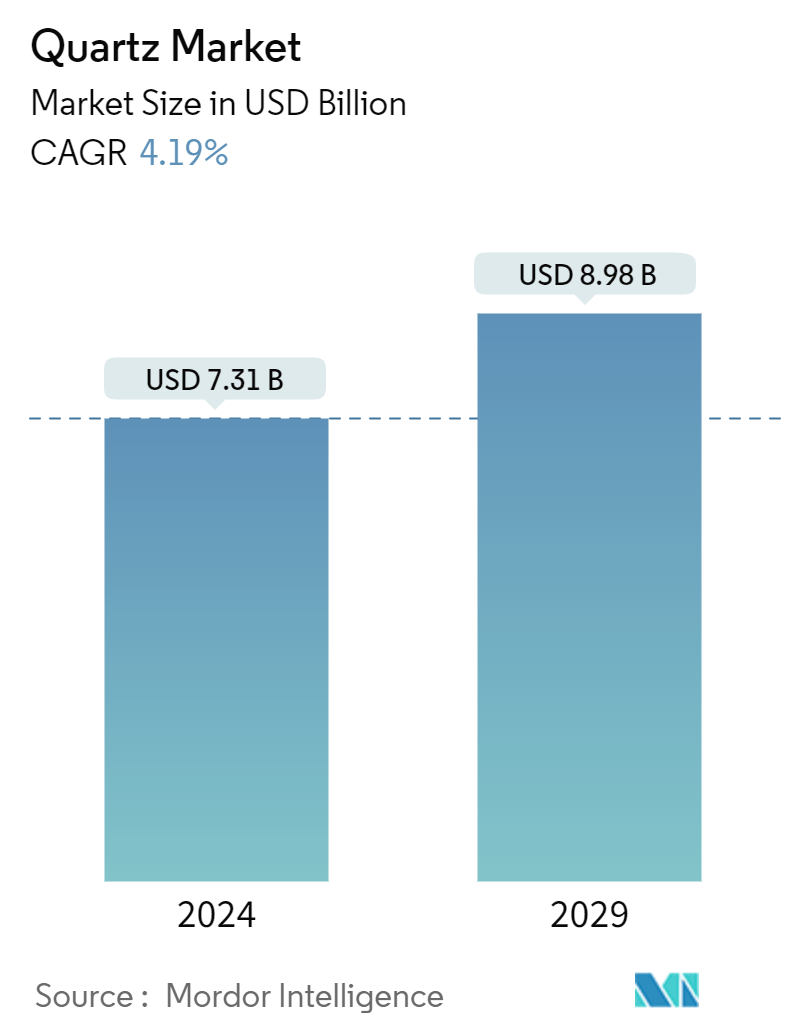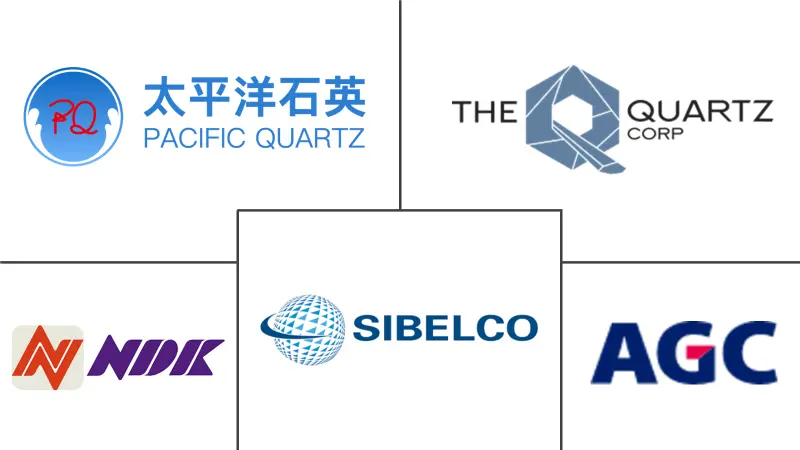Market Size of Quartz Industry

| Study Period | 2018 - 2029 |
| Market Size (2024) | USD 7.31 Billion |
| Market Size (2029) | USD 8.98 Billion |
| CAGR (2024 - 2029) | 4.19 % |
| Fastest Growing Market | Asia Pacific |
| Largest Market | Asia Pacific |
Major Players
*Disclaimer: Major Players sorted in no particular order |
Quartz Market Analysis
The Quartz Market size is estimated at USD 7.31 billion in 2024, and is expected to reach USD 8.98 billion by 2029, growing at a CAGR of 4.19% during the forecast period (2024-2029).
The COVID-19 pandemic halted the supply chain of several industries worldwide, including electronics and semiconductors, building and construction, and automotive. It, in turn, adversely affected the demand for quartz in these industries. Solar power usage increased, but this alone could not lift the market back. The COVID-19 pandemic impacted the global construction industry, with projects facing labor shortages, supply chain issues, and financing pressures. The effects rippled across the sector, from the initial crisis in China to construction sites worldwide. However, as the lockdowns were lifted in most countries worldwide, the market has recovered due to production resumed in most industries.
- Over the mid-term, the primary factor driving the market's growth is the demand for high-purity quartz in the semiconductor industry, coupled with the growing solar industry.
- The ecological impact of quartz mining, coupled with discoloration in quartz tiles and slabs, is anticipated to hinder the market's growth during the forecast timeframe.
- Due to its unique properties, emerging applications of quartz powder can act as an opportunity for the market.
- Asia-Pacific dominated the global market, with the most significant consumption in China.
Quartz Industry Segmentation
Quartz crystals possess piezoelectric properties. It is one of the hardest naturally occurring minerals that does not corrode easily. The market is segmented by type, end-user industry, and geography. The market is segmented by type: quartz surface and tile, high-purity quartz, fused quartz crucible, quartz glass, quartz crystal, quartz sand, plastic foam, and other types. By end-user industry, the market is segmented into electronics and semiconductors, solar, buildings and construction, medical, optics and telecommunication, and other end-user industries. The report also covers the market size and forecasts for the quartz market in 16 countries across major regions. For each segment, the market sizing and forecasts have been done based on revenue (USD million).
| Type | |||||
| |||||
| Quartz Crystal | |||||
| Silicon Metal |
| End-user Industry | |
| Electronics and Semiconductor | |
| Solar | |
| Buildings and Construction | |
| Optical fiber and Telecommunication | |
| Automotive | |
| Other End-user Industries |
| Geography | ||||||||
| ||||||||
| ||||||||
| ||||||||
| ||||||||
|
Quartz Market Size Summary
The quartz market is poised for growth, driven primarily by its increasing demand in the semiconductor and electronics industries. The market experienced disruptions due to the COVID-19 pandemic, which affected supply chains across various sectors, including electronics, semiconductors, construction, and automotive industries. However, as global economies reopened and production resumed, the market began to recover. The semiconductor industry, particularly in the United States, plays a significant role in this growth, with substantial investments planned to meet the rising demand for quartz in microchip production. Additionally, the burgeoning solar industry contributes to the market's expansion, despite challenges such as the ecological impact of quartz mining and issues related to discoloration in quartz tiles and slabs.
Asia-Pacific remains a dominant region in the quartz market, with China leading in consumption due to its robust construction and industrial sectors. The Chinese government's initiatives, such as the "Made in China 2025" plan, aim to boost domestic production and meet local demand, further driving the market. Other countries in the region, like India, Vietnam, and South Korea, are also witnessing growth in their electronics and semiconductor industries, which is expected to increase quartz demand. The market is characterized by fragmentation, with key players like AGC Inc., Nihon Dempa Kogyo Co. Ltd, and Quartz Corporation actively participating in strategic moves to strengthen their market positions.
Quartz Market Size - Table of Contents
-
1. MARKET DYNAMICS
-
1.1 Drivers
-
1.1.1 Growing Solar Industry
-
1.1.2 Demand for High-purity Quartz in the Semiconductor Industry
-
-
1.2 Restraints
-
1.2.1 Ecological Impact of Quartz Mining
-
1.2.2 Discoloration in Quartz Tiles and Slabs
-
-
1.3 Industry Value Chain Analysis
-
1.4 Porter's Five Forces Analysis
-
1.4.1 Bargaining Power of Suppliers
-
1.4.2 Bargaining Power of Consumers
-
1.4.3 Threat of New Entrants
-
1.4.4 Threat of Substitute Products and Services
-
1.4.5 Degree of Competition
-
-
-
2. MARKET SEGMENTATION (Market Size in Value)
-
2.1 Type
-
2.1.1 High-purity Quartz
-
2.1.1.1 Quartz Surface and Tile
-
2.1.1.2 Fused Quartz Crucible
-
2.1.1.3 Quartz Glass
-
-
2.1.2 Quartz Crystal
-
2.1.3 Silicon Metal
-
-
2.2 End-user Industry
-
2.2.1 Electronics and Semiconductor
-
2.2.2 Solar
-
2.2.3 Buildings and Construction
-
2.2.4 Optical fiber and Telecommunication
-
2.2.5 Automotive
-
2.2.6 Other End-user Industries
-
-
2.3 Geography
-
2.3.1 Asia-Pacific
-
2.3.1.1 China
-
2.3.1.2 India
-
2.3.1.3 Japan
-
2.3.1.4 South Korea
-
2.3.1.5 Rest of Asia-Pacific
-
-
2.3.2 North America
-
2.3.2.1 United States
-
2.3.2.2 Canada
-
2.3.2.3 Mexico
-
-
2.3.3 Europe
-
2.3.3.1 Germany
-
2.3.3.2 United Kingdom
-
2.3.3.3 Italy
-
2.3.3.4 France
-
2.3.3.5 Russia
-
2.3.3.6 Rest of Europe
-
-
2.3.4 South America
-
2.3.4.1 Brazil
-
2.3.4.2 Argentina
-
2.3.4.3 Rest of South America
-
-
2.3.5 Middle East & Africa
-
2.3.5.1 Saudi Arabia
-
2.3.5.2 South Africa
-
2.3.5.3 Rest of Middle East & Africa
-
-
-
Quartz Market Size FAQs
How big is the Quartz Market?
The Quartz Market size is expected to reach USD 7.31 billion in 2024 and grow at a CAGR of 4.19% to reach USD 8.98 billion by 2029.
What is the current Quartz Market size?
In 2024, the Quartz Market size is expected to reach USD 7.31 billion.

